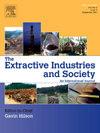From socio-environmental conflict to responsible lithium mining: understanding the Governance of Dispossession from the salt flats of Chile and Argentina
IF 4.3
2区 社会学
Q2 ENVIRONMENTAL STUDIES
Extractive Industries and Society-An International Journal
Pub Date : 2025-09-22
DOI:10.1016/j.exis.2025.101724
引用次数: 0
Abstract
Globally, decarbonisation policies are driving interest and speculation around the extraction of minerals such as lithium, which is mostly found in Indigenous and rural territories in the Puna de Atacama, within the transborder Circumpuneña Region. In this deployment, capital expansion has driven public-private strategies that seek to respond to territorial tensions and expand mineral extraction. Based on militant research situated in long-term relations with territorial resistances and nature protection initiatives in the region, in this article, we analyse this set of practices in four salt flats in Chile and Argentina. We argue that lithium extractivism expands through a ‘governance of dispossession’ model that responds to an emerging global scenario marked by the emergence of new public-corporate arrangements pushed by global powers seeking to ensure their access to so-called critical minerals more responsibly. These strategies also adapt to the local contexts marked by conflicts and tensions between Indigenous communities, mining companies, and State agencies to achieve legitimation. Moreover, the dispossession dynamics linked to lithium exploitation are enabled by a social engineering developed not only by mining corporations and State institutions, but also by car makers, civil society organisations, international cooperation organisations and, eventually, both public and private research centres. We conclude that these adaptations, far from being a solution to socio-environmental conflicts and Indigenous demands for FPIC, translate into a sophistication of the impacts of green extractivism in the Puna de Atacama. As we observe lithium companies' progressive adaptation of voluntary mining standards, we suggest that understanding the social and material impacts of brine mining in the Andean salt flats through independent, transdisciplinary studies is essential for impactful research and rightful policymaking.
从社会环境冲突到负责任的锂矿开采:理解智利和阿根廷盐滩的剥夺治理
在全球范围内,脱碳政策正在推动人们对锂等矿物开采的兴趣和猜测,锂主要存在于跨境Circumpuneña地区的阿塔卡马Puna de Atacama的土著和农村地区。在这种部署中,资本扩张推动了寻求应对领土紧张局势和扩大矿产开采的公私战略。基于与该地区领土抵抗和自然保护倡议的长期关系的激进研究,在本文中,我们分析了智利和阿根廷四个盐滩的这一套做法。我们认为,锂的开采活动通过一种“剥夺治理”模式扩张,这种模式是对新兴的全球情景的回应,其标志是全球大国推动的新的公共-公司安排的出现,以确保他们更负责任地获得所谓的关键矿物。这些战略还适应土著社区、矿业公司和国家机构之间的冲突和紧张局势,以实现合法化。此外,与锂开采相关的剥夺动态是由一种社会工程实现的,这种社会工程不仅由矿业公司和国家机构开发,而且由汽车制造商、民间社会组织、国际合作组织以及最终由公共和私人研究中心开发。我们的结论是,这些适应,远不是解决社会环境冲突和土著居民对FPIC的要求,而是转化为阿塔卡马Puna de Atacama绿色开采活动的复杂影响。当我们观察到锂公司对自愿采矿标准的逐步适应时,我们建议通过独立的跨学科研究了解安第斯盐滩卤水开采的社会和物质影响,这对于有影响力的研究和合理的政策制定至关重要。
本文章由计算机程序翻译,如有差异,请以英文原文为准。
求助全文
约1分钟内获得全文
求助全文
来源期刊

Extractive Industries and Society-An International Journal
ENVIRONMENTAL STUDIES-
CiteScore
6.60
自引率
19.40%
发文量
135
 求助内容:
求助内容: 应助结果提醒方式:
应助结果提醒方式:


